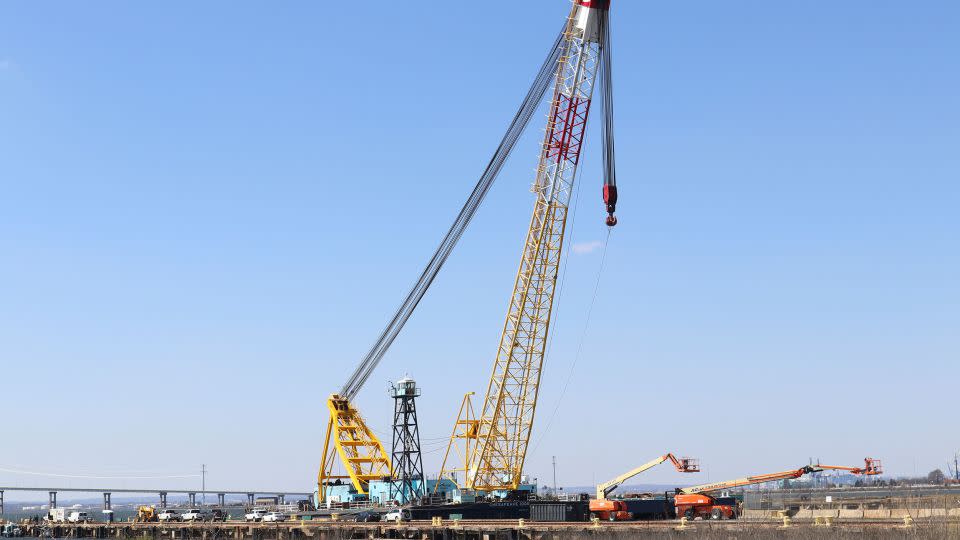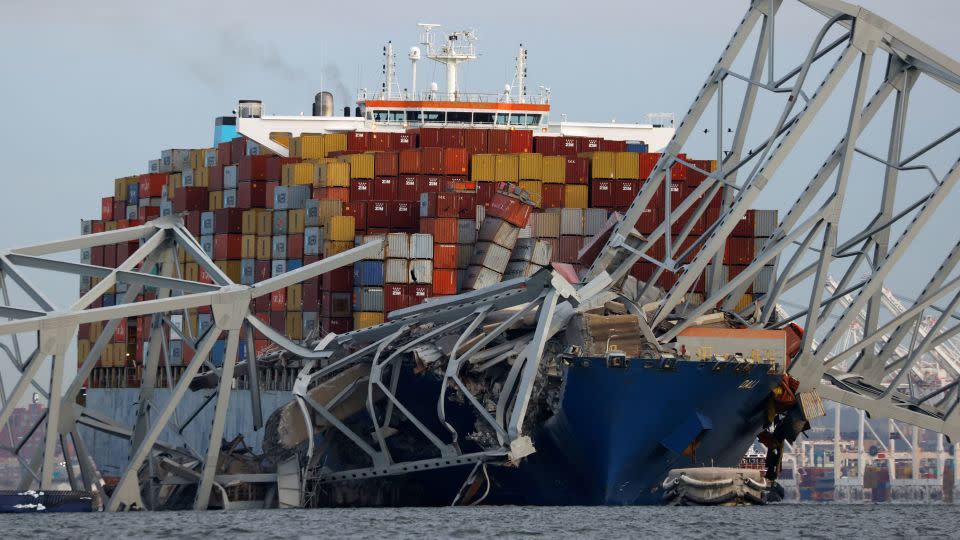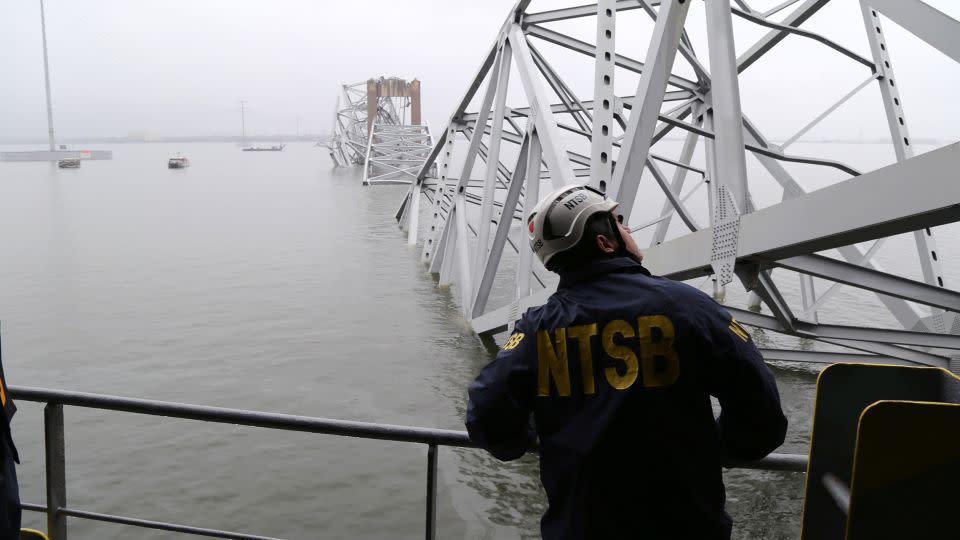Here’s how crews will remove up to 4,000 tons of debris to help find victims of the Baltimore bridge collapse
The largest crane on the East Coast will soon try to lift the treacherous, colossal wreckage that has hampered search crews from finding victims of this week’s catastrophic Baltimore bridge collapse.
The Chesapeake 1000 – a gargantuan floating crane – arrived Friday near the scene where a 213-million-pound cargo vessel slammed into the Francis Scott Key Bridge, destroying the vital thoroughfare and killing six construction workers. Four of their bodies have not been found.
The crane can lift 1,000 tons of debris, Maryland Gov. Wes Moore said Friday. But “one of the challenges is that the Key Bridge, which sits on top of the vessel right now, that weight is somewhere between 3,000-4,000 tons,” Moore said.
That means massive hunks of debris will have to be cut up before they are removed. But crews will try to work quickly so they can resume their search for the missing victims and reopen a cargo channel critical to the local and national economies – a feat that officials say could take weeks.

Live updates: The latest on the Baltimore bridge collapse
More heavy equipment is expected at the scene in the coming weeks. That includes seven floating cranes, 10 tugs, nine barges, eight salvage vessels and five Coast Guard boats, Moore said.
Workers at the scene still face “an incredibly complex job,” the governor said.
“When you have a chance to see that wreckage up close, you fully understand the enormity of the challenge,” the governor said. “Our timeline will be long.”

The cargo ship – about the length of three football fields – has as much as 4,000 tons of steel frame hanging on its bow since the ship plowed into the Key Bridge – sending a crew of construction workers plunging to the frigid water below.
It could take days before the first piece of the massive wreckage is cut and lifted out of the way, according to Scott Spellmon, commanding general of the US Army Corps of Engineers. More than 1,000 engineers in Baltimore and across the country are studying the wreckage piece-by-piece to figure out the best plan to remove the wreckage.
“I believe it will be several more days of this type of analysis before we can start cutting and lifting members,” Spellmon told CNN. “There is a massive steel truss bridge going across that channel and at the bottom, 50 feet down, there are possibly some containers and other heavy debris that we have to get off the floor.”
He added it could take weeks for the channel to reopen. “I don’t think we’re talking days, I don’t think we’re talking months … I think we’re talking weeks,” he said. “I just can’t put a number on it yet until we get our analysis complete.”
Only two of those workers survived. The bodies of two others were later pulled from the water. Authorities believe the remaining four victims are trapped in the tangle of steel and concrete under water.
Recovering those victims is a top priority, and it is “our obligation to bring a sense of closure to these families,” Moore said.
In addition to the human toll, the destruction of the Key Bridge and closure of the Port of Baltimore could lead to widespread economic fallout.
The port is the largest in the US for cars and light trucks, handling a record 850,000 vehicles last year, Moore said.
Demolition workers may be able to clear a channel large enough for ships to pass through as soon as a month after the required equipment arrives at the scene, according to an expert in the field familiar with ongoing discussions.
The expert, who spoke to CNN on condition that his name not be used, said it will likely take longer than that to remove all the debris. But clearing the 1,200-foot area between the two pillars that supported the bridge’s main span will be enough to reopen the port to traffic.
Over 2,400 feet of boom has also been deployed to contain any potential pollution leaks from the ship, Moore said.
National Transportation Safety Board investigators have said 56 containers on the vessel contain hazardous material, mostly corrosives and flammables, as well as some lithium-ion batteries.
The Army Corps will cover the full cost of clearing the channel where the bridge collapsed, Maryland Sen. Chris Van Hollen said.
Federal transportation officials will provide the $60 million requested by Moore as a “down payment” toward clearing and rebuilding the Key Bridge, the governor said. The funds will go toward removing debris, rerouting traffic and ultimately rebuilding the bridge.
Maryland can request additional funding later, and the state’s congressional delegation said they would press fellow lawmakers to fund the rebuilding project.
‘This is about the nation’s economy’
The economic fallout of the bridge collapse could be wide-ranging as the crisis has indefinitely halted the flow of ships in and out of the Port of Baltimore and delivered a stunning blow to the thousands of dock workers who rely on the busy port.
“This is not just about Maryland, this is about the nation’s economy,” Moore said Thursday.
“The port handles more cars and more farm equipment than any other port in America. And at least 8,000 workers on the docks have jobs that have been directly affected by this collapse.”
To help port workers, the Maryland Department of Labor has established a hotline for unemployment insurance, the governor said.
Ports up and down the East Coast are gearing up to temporarily accommodate cargo shipments that would have otherwise arrived in Baltimore.
And several sectors will have to reroute supply chains, including railroad and trucking operations, US Transportation Secretary Pete Buttigieg told CNN Thursday.
Earlier, the governors of New York and New Jersey said their Port Authority could take on additional cargo to minimize supply chain disruptions.
Managing supply chain disruptions and reopening the port “is not going to be a small project by any stretch,” Buttigieg said.
“We know that it’s going to be costly,” he said. “But we also know that that cost is worth it to get Baltimore back on its feet, to get everything back to normal and to support our traffic systems and supply chains.”
Investigators interview the ship’s crew
The National Transportation Safety Board has been gathering evidence at the scene of the crash, interviewing witnesses and analyzing the ship’s data recordings.
Two pilots who were tasked with guiding the ship out of port were expected to be interviewed by authorities Thursday. The vessel’s captain, his mate, the chief engineer and another engineer have already spoken to investigators, NTSB chair Jennifer Homendy said.
Investigators have used audio and data from the 213-million-pound ship’s voyage data recorder to extract clues as to what happened in the moments leading up to the collision.

The first sign of distress came just under three minutes before the crash when the cargo ship’s pilot called over the radio requesting any tugboats in the area to respond to the vessel, Homendy said.
Within a minute, police officers on both ends of the bridge were ordered to stop traffic crossing the bridge, said Marcel Muise, the NTSB investigator in charge of the collapse inquiry. Officials have credited this swift action for saving lives.
During their first full day at the scene Wednesday, investigators saw the “utter devastation” of the mangled bridge – pieces of which are still draped over the ship’s bow, Homendy said.
The Dali, a Singaporean-flagged container vessel, had 23 people on board – 21 crew members and two pilots. Of the crew members, 20 are Indian nationals who were “in good shape” after the crash, India’s Ministry of External Affairs said Thursday.
CNN’s Justin Lear, Andy Rose, Sarah Dewberry, Chris Isidore, David Goldman, Paradise Afshar, Greg Wallace, Aaron Cooper, Elise Hammond, Tori B. Powell, Vedika Sud, Sania Farooqui and Chris Boyette contributed to this report.
For more CNN news and newsletters create an account at CNN.com
